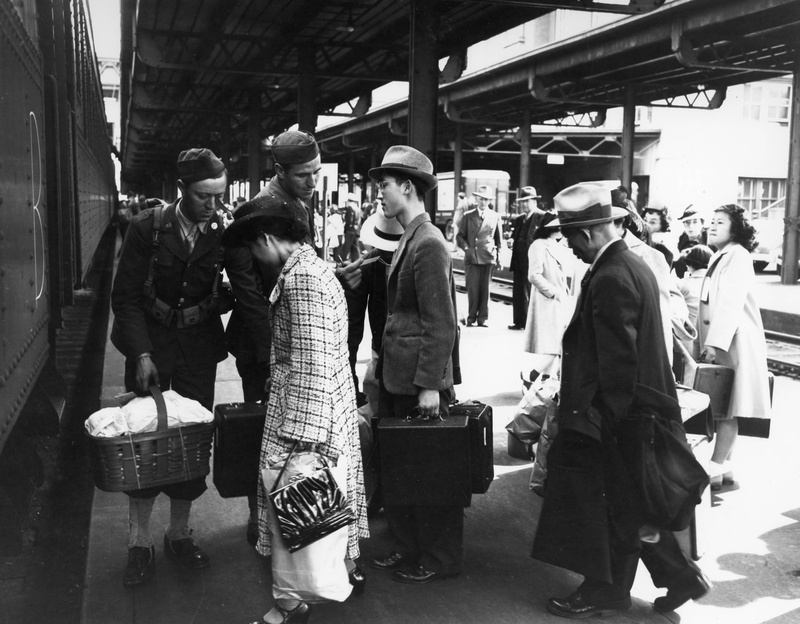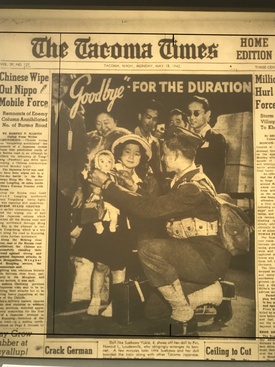I am thinking about paths, footsteps, gravel, listening, memory.
When I visited the Bainbridge Island Japanese American Exclusion Memorial wall a few years ago, I was fascinated by the architectural design details that I heard—all lovingly told by Bainbridge Island Japanese American Community president Clarence Moriwaki. The memorial is strategically placed next to the very same path where the first Japanese Americans walked on their way to the ferry terminal for their wartime forcible removal.
The memorial wall winds next to a gravel path. The gravel, Clarence said, was placed there on the path so that people could hear their own footsteps.
Listening to one’s own footsteps, I have found, is something like the work of writing history, and planning Days of Remembrance. I am thinking about these days as days of action because they are works of memory—and memory works across time, space, and silence.
* * * * *
Together with historian Michael Sullivan and a small group of community members, I’m planning a Day of Remembrance for my adopted hometown, Tacoma, Washington. Michael and I have been writing about Japanese American history in Tacoma separately and together for a few years now.
Tacoma has had other Days of Remembrance, but to the best of my knowledge, those haven’t happened since the late 1990s. Historian Ron Magden (whose book Furusato: Tacoma-Pierce County Japanese is still a definitive resource) organized these events, along with Tacoma resident Joe Kosai.
Part of the difficulty of having Days of Remembrance is that the Japanese American population here is small; despite a thriving Japantown in the early part of the 20th century, only one out of seven returned to Tacoma after the war. (The Tacoma Buddhist Temple congregation, however, is a steadfast and growing community.) Others resettled near San Francisco, or Chicago.
With the 75th anniversary of the signing of Executive Order 9066, 2017 has been a banner year for events about Japanese American wartime history. Dukesbay Theater put on a successful staged reading of testimonies from Japanese American incarcerees. Michael and I did a walking tour in February, in conjunction with our Broadway Center’s production of the play Nihonjin Face. We expected 10 or 15 people for the walking tour; 80 showed up. All three performances of Nihonjin Face sold out. This series of events felt different than past events; the larger Tacoma community was talking about local Japanese American history.
“You know,” Michael said when our tour was over, “we should really mark the day these neighbors left Tacoma. We should have people stand where these people stood, at Union Station.”
“What day was that?” I asked.
“May 17 and 18th,” he replied.
And so: our 2017 Tacoma Day of Remembrance.
On May 18, 2017, we will take a short walk from the Washington State History Museum to Union Station. We’ll stand approximately where 879 Japanese Americans stood, and we’ll honor their footsteps.
* * * * *
Michael is a local historian, a storyteller, a passionate champion of local history. I asked him what planning this Day of Remembrance means to him, since he is not Japanese American:
A shared sense of history builds a community’s cultural strength and wellbeing. Not every aspect of a city’s past is heroic or honorable and sometimes the hardships and injustices that have been experienced pull people together better than the victories and successes.
Tacoma may well have lost more than any other west coast city in America because of Executive Order 9066 and the subsequent internments but it also distinguished itself by speaking up about the injustices being played out. In observing a day of remembrance for the loss of Tacoma’s Japantown, I hope people will see their city through a longer lens and appreciate its many stories for the value they provide in making good decisions about the future.
* * * * *
Though Michael and I have only been planning the event for a couple of months, we’ve been delighted at the response. We have team members who are helping to create an official city proclamation. Our local major theater company, the Broadway Center, has offered us a screening of Nihonjin Face, set in Tacoma; one of the playwrights, Densho’s Janet Hayakawa, will also be there for a post-screening discussion. The Washington State History Museum has generously offered us its spaces since it is open later on “Third Thursday,” a free art walk day. An exhibit focusing on Japanese Americans happens to be at the History Museum, and closes a couple of days after our Day of Remembrance. The Tacoma Buddhist Temple has offered to open its doors to the public for the walking tour, so that participants can see historic photos and sites from Japantown’s past, as well as the presence of a growing temple community. In the single week since we’ve posted the event on Facebook, over four hundred people have already expressed interest in the day.
* * * * *
Another path, a historic one.
I am thinking about what was going on behind the smiles and posed pictures that the Tacoma Times and the Tacoma Daily Ledger posted. Onlookers were discouraged from attending, and close to 100 armed military personnel were present. “Like Tourists, Japs Head South,” reported the Tacoma Daily Ledger. “Smiles Prevail as Japanese Leave,” reported the Tacoma Times. Stories from the Japanese Americans who were leaving suggest something different.
Young Yaeko Nakano wrote in her diary: “The last day in Tacoma. Feel kinda blue, but also looking forward to our trip. We bade farewell to all our friends and that was hardest of all. Around 1:00, went down to Chinese Garden, had our last meal in Tacoma. Sort of a shame, but I stuffed myself when I thought, ‘I won’t be able to eat that kind of a food for some time.’ At a quarter to three we locked our front door, looked around the garden, and with a sort of empty feeling, turned our back on our home for the last ten years. The station was a hubnub of people all trying to look unconcerned, and doing a pretty good job at that.”1
Tadaye (Teddy) Fujimoto Kawasaki, one of three Fujimoto sisters, recalled in a 1993 interview: “The only thing I remember is our neighbor leaning on the—Mrs. Alvey was elderly, she was just crying and crying. She knew that she probably wouldn’t see us again, you know.”2
I am thinking about all the pictures of the children that were posted that day—pictures that are difficult for me to see as a mother. One little girl is carrying all that she can carry. Two bags.
* * * * *
Still another path: that of Seattle Japanese Americans, and others around the country.
Living in Tacoma, we’re just a few miles away from the Washington State Fairgrounds—site of the very first Japanese American Day of Remembrance in Puyallup, Washington. A caravan of cars came down from Seattle to Puyallup, complete with buses, speakers, a potluck, and much more. My artist friend Mizu Sugimura sent me some of her personal pictures of the day.
Since then, Days of Remembrance have been observed all over the country, from San Francisco to Denver to New York City. They’re usually scheduled in February, to mark the anniversary of the signing of Executive Order 9066, but we are scheduling Tacoma’s for May, to avoid conflict with other events in the area. On September 2, 2017, the Puyallup Valley Japanese American Citizens League will be holding its own remembrance event to rededicate the monument at the Puyallup fairgrounds and honor those who were incarcerated in the assembly center called “Camp Harmony.”
I am thinking about other Days of Remembrance events I’ve attended in other cities, including a memorable one in San Francisco when my uncle Hiroshi Kashiwagi lit the candle representing Tule Lake among the candles representing all 10 camps. More footsteps.
* * * * *
I am thinking about gravel paths, the gravel paths in the parking lot of my childhood Buddhist temple in Penryn, California; about the gravel path that led up to my oldest auntie’s house in Loomis, California; about that gravel path that winds next to a beautiful monument wall with origami cranes on Bainbridge Island.
I’ve come to love my adopted hometown, and to discover its rich Japanese American history has been a gift over these last four years. It has given me roots as well as a place rich with discovery. In a sense, then, Tacoma’s Day of Remembrance is for me a small gift back.
I am thinking about how painfully relevant these Days of Remembrance are, in light of deportation raids, travel bans, xenophobia, and detention centers. In Tacoma we have a privately owned and privately run detention center, where detainees are holding a hunger strike to protest their living conditions; immigrant and detainee rights here are not idle discussions. To offer resources for those who want to help immigrants and refugees, we are hosting a table from the Tacoma Community House, a community services center that offers resources to those in need, including those populations.
The power of place sometimes means that we can retrace history; we retrace history hopefully in order to not repeat it. And so I am thinking about the power of place, about needing to listen to my own footsteps, and to listen to the footsteps of those who have been on this path before me; to listen to the footsteps of those with me and those yet to come.
We hope people can come.
Notes:
1. “Yaeko Nakano—Kenichi Nakano—Hiroshi Nakano—Stanley Nakano,” interview with Tracy Lai, July 4, 1998. Densho Archive, denshovh-nyaeko_g-01-0001
2. Transcript of Brenda Sonnier interview with Tadaye (Teddy) Fujimoto Kawasaki, Yoshiko Fujimoto Sugiyama, and Kimi Fujimoto Tanbara, February 22, 1993. University of Washington Community History Project, Page 23.
© 2017 Tamiko Nimura









